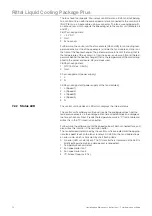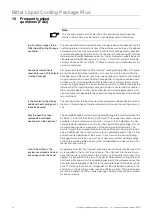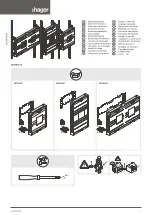
83
Operating and Maintenance Instructions – 10 Frequently asked questions (FAQ)
Rittal Liquid Cooling Package Plus
Is a raised floor necessary for
installation? If yes, what height
is required?
A raised floor is not required for routing the cooling water pipes. In principle,
the pipes can also be laid in channels in the floor. A main cooling pipe requires
approx. 150 mm headroom in a raised floor; an enclosure supply line approx.
50 mm. With high-quality composite pipes, such as those used in underfloor
heating, an extremely flexible routing of the cooling water pipelines is possible.
Can LCP-cooled enclosures
also be bayed with one
another?
Basically, the Liquid Cooling Package is just a "small" enclosure. That means
that all accessories for baying may be used. Thus, LCP-cooled systems may
be bayed without limitation.
How is condensate formation
prevented in the Liquid Cooling
Package?
Condensation can only occur when air is significantly cooled below the ambient
temperature. Thus, its capacity to absorb or "hold" water is reduced. In the
norm, the Liquid Cooling Package works with water temperatures above the
dewpoint. Condensate formation is thus excluded. If it is operated with lower
temperatures, the control minimises condensate formation. Any arising con-
densate is effectively hindered from leaving the Liquid Cooling Package
through design measures. These measures include suitable air routing, wipe-
off grids and active condensate management.
How does the Liquid Cooling
Package prevent desiccation?
At the same time that air is cooled, it is also dehumidified. Because of cable en-
try points, the system is not 100% sealed off from its surroundings. This small
amount of exchange with external air is sufficient to hold the air's relative hu-
midity above 30% and thus non-critical. At no time is there the danger of static
charges arising in the enclosure.
Can the Liquid Cooling
Package be operated together
with the CPU cooling solution?
A combination of direct CPU cooling with water and the Liquid Cooling Pack-
age is always possible. Depending on the computer system, only up to 70% of
the total heat loss is removed through the water heatsinks with direct CPU cool-
ing. In cases of high cooling output requirements, this means that a combina-
tion of systems is even necessary. Please request our documentation for
individual projects separately.
In case a pipe should break or
burst, how is water entry into
the server rack avoided?
Because the components are carefully chosen, it is practically impossible for a
pipe to break. The base unit of each LCP module serves as a water collecting
tray. These are connected to one another, so that any water arising is immedi-
ately led away through the condensate discharge. Through the physical sepa-
ration of the Liquid Cooling Package from the server enclosure, it is always
ensured that no water can enter into the server area. Additionally, the integrated
leakage sensor reports even the smallest leak volumes to allow for a rapid re-
sponse.
Why does the Liquid Cooling
Package allow for the
possibility of cooling one or two
enclosures?
The most important design principle was a flexible cooling system which would
correspond to the enormous volume of air required by a modern server. Be-
cause of the horizontal cooling possibility, options for "right", left" or "both-sided"
cooling arise in combination with the chosen fans. Cooling a server rack with
two Liquid Cooling Packages has the advantage of complete system redun-
dancy without further removal of 482,6 mm (19") equipment. See also
Chapter 4.3.1, "Possibilities for establishing redundancies".
In which applications and
situations should an air/water
heat exchanger system be
used?
Whenever the cooling output of the room air conditioning system is not suffi-
cient to handle the heat loads of current high performance servers. With an op-
timal design in a newly planned data centre, this limit is at about 1,000 –
1,200 W/m²; in older data centres, it is often significantly below that. At best, a
maximum of 4 kW per rack needs to be removed. By contrast, racks which are
filled with blade servers reach up to 17 kW. But the Liquid Cooling Package
represents a possible solution even in applications where there is no existing
air conditioning system. In combination with Rittal recooling systems, even cli-
mate control solutions for high performance cluster systems can be created.
What additional infrastructure
is required to operate the
system?
In addition to the Liquid Cooling Package, pipes to the individual enclosures
and a system for generating the cooling water are required. With single enclo-
sures, a direct connection with the cooling water is sufficient. With multiple en-
closures, a cooling water distribution system, similar to a central heating
distribution system, should be provided. To a great degree, this infrastructure
corresponds to that which is already used in a conventionally air conditioned
















































